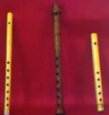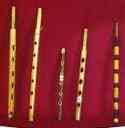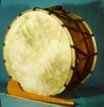Turkish musical folk instruments can be classified as follows:
- String Instruments
- Bow Instruments
- Wind Instruments
- Percussion
Description
Saz (Turkish Long Neck Lute)
The Saz is the grandfather of the Greek Bouzouki. It's originated in Central Asia where Turks lived before their westward migration. Like the guitar in Spain and the bouzouki in Greece, the Saz is the most popular stringed instrument in Turkey. Although similar in shape to the Greek Bouzouki, the construction, size and sound of the Saz is different. You need a baglama saz to be able to play the microtones (Perde) of Arabic music. These instruments have traditional tied frets that are movable, and 3 courses of strings.
Baglama
 Baglama is the most commonly used string folk instrument in Turkey. It takes different names according to the regions and according to its size such as Baglama, Divan Sazi, Bozuk, Çögür, Kopuz Irizva, Cura, Tambura, etc.
Baglama is the most commonly used string folk instrument in Turkey. It takes different names according to the regions and according to its size such as Baglama, Divan Sazi, Bozuk, Çögür, Kopuz Irizva, Cura, Tambura, etc.
Cura is the smallest member of the baglama family with the highest pitched sound. The member one size bigger than cura which gives a sound that is one octave lower than cura is the tambura. And the one with the deepest sound is the Divan sazi whose sound is one octave lower compared to tambura.
Baglama has three main parts called Tekne, Gögüs and Sap. Tekne part is generally made from mulberry trees as well as from woods of juniper, beech, spruce or walnut. The gögüs part is made from spruce and the sap section from homespun or juniper.
There are pieces called burgu (screw) at the end of the sap which is opposite to tekne part to which the strings are tied. These screws are used for tuning. There are pitches on the sap tied with fish line. Baglama is played with a Mizrap or Tezene made from cherry wood bark or plastic and fingers are used in some regions. The later technique is called Selpe.
There are three string groups on Baglama in groups of two or three. These string groups can be tuned in a variety of ways. For example in the tuning style called baglama Düzeni, the strings in the lower group give 'la', middle group strings and upper group strings give 'mi' notes. Besides this type of tuning there are Kara Düzen, Misket Düzeni Müstezat, Abdal Düzeni, Rast Düzeni etc. styles.
Tar
 Tar is a Turkish folk instrument played with a plectrum (tezene). It is widely used in the Kars region. It is also a commonly used instrument in Azerbaijan, Iran, Uzbekistan and Georgia. Its body is composed of two bowls of different size and is generally made from mulberry trees. The gögüs section is covered with a membrane taken from the heart of water buffaloes or cattle. Sap section is from hard wood and fish line pitches are tied onto it.
Tar is a Turkish folk instrument played with a plectrum (tezene). It is widely used in the Kars region. It is also a commonly used instrument in Azerbaijan, Iran, Uzbekistan and Georgia. Its body is composed of two bowls of different size and is generally made from mulberry trees. The gögüs section is covered with a membrane taken from the heart of water buffaloes or cattle. Sap section is from hard wood and fish line pitches are tied onto it.
There are two main groups of strings on tar. Those in the first group are used in playing the tune and consists of three groups of two strings. The other group of strings are called Kök and Zengi and are tuned according to the mode to be used and enhance the tone.
Kabak Kemane
Kabak Kemane is a bowed Turkish folk instrument. Shows variation according to regions and its form. It is known that instruments known as Kabak, Kemane, Iklig, Rabab, Hegit at Hatay province, Rubaba in Southeastern Turkey, Kemana in Azerbaijan and Gicak, Giccek or Gijek among the central Asian Turks all come from the same origin.
Its body or the tekne part is generally made from vegetable marrow but wooden ones are also common. The sap is from hard woods. There is a thin wooden or metal rod underneath the body which is placed on the knee and enables the instrument to move to the left and right. The bow is made by tying horse hair on two ends of a stick. Previously strings made from gut called Kiris were used which were replaced by metal ones at the present.
Kabak kemane is an instrument without pitches and produces all types of chromatic sounds easily. Its sound is suitable for long plays and can be used for legato, Staccato and Pizzicato paces.
Karadeniz Kemencesi
 Karadeniz Kemencesi is a bowed Turkish folk instrument. As can be surmised from its name it is an instrument widely used in the Black Sea Region. Its body is made from mulberry, plum and juniper woods. The wooden part of the bow generally rose wood or box wood. Horse hair is tied to the ends of the bow.
Karadeniz Kemencesi is a bowed Turkish folk instrument. As can be surmised from its name it is an instrument widely used in the Black Sea Region. Its body is made from mulberry, plum and juniper woods. The wooden part of the bow generally rose wood or box wood. Horse hair is tied to the ends of the bow.
Kemence is a three-string instrument. While kiris strings from gut used be put on kemences, these days mostly metal strings are used.
Kemence is an instrument without pitches and and it is possible to get from it all types of chromatic sounds easily. It is generally played by pressing two strings at the same time and getting parallel quarter notes. It is furthermore played with a special technique which is achieved with wrist movements.
Zurna
 Zurna is a Turkish folk instrument of the wind type. Because of its strong sound it is generally played in the open air, on occasions such as village weddings, sending off the boys to military service, sport encounters, folk dances and similar ceremonial events. It was the first melody instrument of the Mehter teams (Janissaries Band) in the Ottoman period. It was also used in some traditional theater (orta oyunu) performances. It is generally accompanied with a drum. Because of the difficulty of its intonation and its high sound level, it is not used in musical groups. However, in the recent years it started to be used by some folk music groups.
Zurna is a Turkish folk instrument of the wind type. Because of its strong sound it is generally played in the open air, on occasions such as village weddings, sending off the boys to military service, sport encounters, folk dances and similar ceremonial events. It was the first melody instrument of the Mehter teams (Janissaries Band) in the Ottoman period. It was also used in some traditional theater (orta oyunu) performances. It is generally accompanied with a drum. Because of the difficulty of its intonation and its high sound level, it is not used in musical groups. However, in the recent years it started to be used by some folk music groups.
Zurna has a sound range of nearly two octaves and has eight melody keys with seven of them on the front and one on the back. The key at the back is so located as to come between the first two notes towards the reed section at the front. The keys are generally round with 6-8mm diameters. The length of the instrument changes between 30 - 60 cm and widens out like a funnel starting from the part the melody holes end. This section is called the kalak. At the blowing end there is a thin pipe like rod over which the reed goes. This rod is called Metem. A separate circular piece with a hole in the middle is put over the Metem to help the breathing technique. This piece is called Avurtluk. The most common zurna playing technique is the continuous playing technique where while the air collected in the cave of the mouth is blown out from the reed, inhaling through nostrils occurs simultaneously.
There are seven holes besides the melody keys on the kalak section which are smaller in diameter. They are called Seytan Deligi (devil's hole) or cin deligi (genie's hole). They can be closed with wax or a similar material according to the sound hunting of the player.
The instrument which changes between 60 and 30 cm. in length as we have already mentioned is divided into three types according to its sound : Kaba Zurna, Orta Kaba Zurna and Cura Zurna (Zil Zurna). They are generally made from wood of trees such as plums, apricots, walnut, saber etc.
Kaval
 Kaval is a Turkish folk instrument of the wind type. It is known as the instrument of the shepherds. It is also called Guval and Kuval in different regions. The belief that the shepherd leads his sheep flock with his kaval is a wide spread belief among the people. The word kaval is probably a derivative from the word "kav" which means hollow on the inside.
Kaval is a Turkish folk instrument of the wind type. It is known as the instrument of the shepherds. It is also called Guval and Kuval in different regions. The belief that the shepherd leads his sheep flock with his kaval is a wide spread belief among the people. The word kaval is probably a derivative from the word "kav" which means hollow on the inside.
Its sound range is about 2.5-3 octaves. It is widely used instrument in the folk music groups of today and can be used as a solo instrument within an ensemble. Kaval preserves its sound characteristics when played together with other instruments.
As kavals are not produced to any defined standards what can be said about its dimensions has to be very general. Its length may vary between 30 cm and 80 cm and its diameter is approximately 1.5 cm. It has 7 melody keys on the front and one underneath. Besides these, there are also 4 other keys at the lower section of the instrument called Seytan Deliği and Hazreti Ali.
Kavals are divided into two main types as Dilli Kaval and Dilsiz Kaval and are generally made from the wood of the plum tree.
Çigirtma
 Cigirtma is a Turkish folk instrument of the wind type. Cigirtma is made from the wing bone of the eagle. It is known to be used mostly by the shepherds and is an almost forgotten instrument today. It has a total of seven melody keys with six on the top and one underneath It is about 15-30 cm long.
Cigirtma is a Turkish folk instrument of the wind type. Cigirtma is made from the wing bone of the eagle. It is known to be used mostly by the shepherds and is an almost forgotten instrument today. It has a total of seven melody keys with six on the top and one underneath It is about 15-30 cm long.
Mey
 Mey is a Turkish folk instrument of the wind type. It consists of three parts. Ana Gövde (main part), Kamis (reed) and Kiskac (clip). The clips mounted to the end of the reed and can be pushed up and down on the reed and thus enabling tuning by providing one note variation in the sound.
Mey is a Turkish folk instrument of the wind type. It consists of three parts. Ana Gövde (main part), Kamis (reed) and Kiskac (clip). The clips mounted to the end of the reed and can be pushed up and down on the reed and thus enabling tuning by providing one note variation in the sound.
Mey which is made of wood from plum walnut, beech etc. has sound distance of about one octave. It has a total of eight melody keys with seven on top and one underneath. There are three types of Mey: Cura Mey, Orta Mey and Ana Mey. Mey is called Balaban in Azerbaijan.
Tulum
Tulum (bagpipe) is a Turkish folk instrument of the wind type. It consists of three parts with Deri Kismi (leather section), Nav and Agizlik (mouth piece). The air is stored in the leather section and is let into the nav section by pressing the bag under the arm. Nav is the part where the melody is played. It also has two parts called Analik and Dillik. Agizlik is the section which sends the air to the leather bag of the pipe.
Tulum is used in Turkey at Trabzon, Rize, Erzurum, Kars, Northern and Eastern Anatolian regions and in Thrace. Tulum, which is generally made from lamb or kid skin, is called Gayda in Thrace.
Sipsi
 Sipsi which is a Turkish folk instrument of the wind type is made from bone, wood or reed. The reed ones are more common. It has a second smaller part at the end which is made of reed that produces the sound. This part is completely taken into the mouth and the air is blown.
Sipsi which is a Turkish folk instrument of the wind type is made from bone, wood or reed. The reed ones are more common. It has a second smaller part at the end which is made of reed that produces the sound. This part is completely taken into the mouth and the air is blown.
It is most widely used in the Aegean Region the instrument has a total of six melody keys with five on the top and one underneath.
Çifte
 Cifte is a Turkish folk instrument of the wind type. It is made by tying two reed pipes side by side. Two small reed pieces which produce the sound are added to the ends of both reeds. These two small reeds are taken into the mouth cavity and it is played by blowing the air at the same time.
Cifte is a Turkish folk instrument of the wind type. It is made by tying two reed pipes side by side. Two small reed pieces which produce the sound are added to the ends of both reeds. These two small reeds are taken into the mouth cavity and it is played by blowing the air at the same time.
There are two cifte types known as Demli cifte and Demsiz cifte. In demli Cifte one of the reeds does not have any pitch keys and it just produces a background sound. There are melody keys on the other red and the main melody is played through them.
Cifte is also known as Argun, Argul, Kargin or Zambir at different regions.
Davul
 Davul (drum) is the oldest known percussion instrument. It can be in different sizes and is generally used in open spaces on occasions such as weddings, folk dances or different ceremonies. It consists of a circular wooden frame and a hoop made from two skins and covered with skin which is put on the frame with the help of strong strings or leather ribbons.
Davul (drum) is the oldest known percussion instrument. It can be in different sizes and is generally used in open spaces on occasions such as weddings, folk dances or different ceremonies. It consists of a circular wooden frame and a hoop made from two skins and covered with skin which is put on the frame with the help of strong strings or leather ribbons.
It is played while hung on the shoulder with knitted or leather strap. The skin on one side of the drum is thick while on the other is thinner. The thin one is made from goat, the thick one from sheep skin. The thick skin side is hit with a tokmak and the thin skinned one with a light wooden stick. It is possible to scan or treble with the thin stick. The drum can either be played hung to the shoulder or holding it under the arm and using hands.
Davul is especially used during Ramadan to wake people up before beginning the fast.
Nagara
 Nagara (Koltuk Davulu) is a Turkish folk drum or percussion instrument. It is placed under the arm and beaten with hands. It is longer compared to the regular drums and its diameter is smaller.
Nagara (Koltuk Davulu) is a Turkish folk drum or percussion instrument. It is placed under the arm and beaten with hands. It is longer compared to the regular drums and its diameter is smaller.
Tef
 Tef (tambourine) is a Turkish percussion instrument. It consists of a metal or wooden hoop over which a skin is stretched. There are two types of tambourines, with or without the cymbals.
Tef (tambourine) is a Turkish percussion instrument. It consists of a metal or wooden hoop over which a skin is stretched. There are two types of tambourines, with or without the cymbals.
Kasik
 Kasik (spoon) is a Turkish percussion instrument. The ones made from boxwood are particularly favored. The handles are taken between the fingers and the oval parts are held towards the inside of the hand in a back to back position. There are also different holding styles.
Kasik (spoon) is a Turkish percussion instrument. The ones made from boxwood are particularly favored. The handles are taken between the fingers and the oval parts are held towards the inside of the hand in a back to back position. There are also different holding styles.

